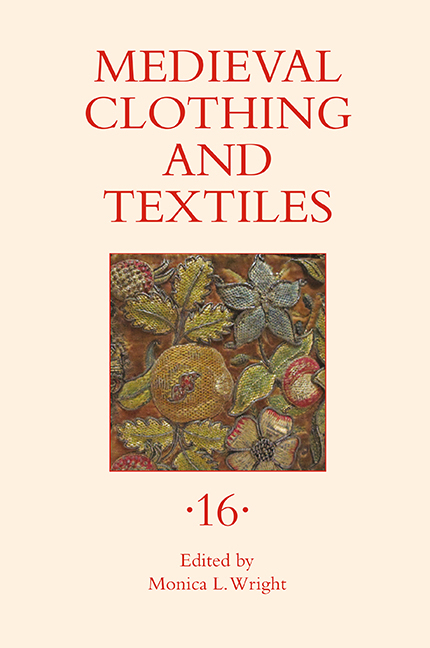Book contents
- Frontmatter
- Contents
- Illustrations
- Tables
- Contributors
- Preface
- 1 Anglo-Saxon Banners and Beowulf
- 2 The Use of Curved Templates in the Drawing of the Bayeux Tapestry
- 3 Construction and Reconstruction of the Past: The Medieval Nordic Textile Heritage of Hemp
- 4 Historicizing the Allegorical Eye: Reading Lady Mede
- 5 Sex, Lies, and Verdugados: Juana of Portugal and the Invention of Hoopskirts
- 6 Fashion and Material Culture in the Tabletop of the Seven Deadly Sins Attributed to Hieronymus Bosch
- 7 The Broderers’ Crown: The Examination and Reconstruction of a Sixteenth-Century City of London Livery Company Election Garland
- Appendix 7.1 Surviving Sixteenth-and Seventeenth-Century Embroidered Crowns of the City of London Livery Companies
- Recent Books of Interest
- Author Index, Volumes 1–15
2 - The Use of Curved Templates in the Drawing of the Bayeux Tapestry
Published online by Cambridge University Press: 27 March 2021
- Frontmatter
- Contents
- Illustrations
- Tables
- Contributors
- Preface
- 1 Anglo-Saxon Banners and Beowulf
- 2 The Use of Curved Templates in the Drawing of the Bayeux Tapestry
- 3 Construction and Reconstruction of the Past: The Medieval Nordic Textile Heritage of Hemp
- 4 Historicizing the Allegorical Eye: Reading Lady Mede
- 5 Sex, Lies, and Verdugados: Juana of Portugal and the Invention of Hoopskirts
- 6 Fashion and Material Culture in the Tabletop of the Seven Deadly Sins Attributed to Hieronymus Bosch
- 7 The Broderers’ Crown: The Examination and Reconstruction of a Sixteenth-Century City of London Livery Company Election Garland
- Appendix 7.1 Surviving Sixteenth-and Seventeenth-Century Embroidered Crowns of the City of London Livery Companies
- Recent Books of Interest
- Author Index, Volumes 1–15
Summary
The Bayeux Tapestry is an eleventh-century embroidered frieze. It is 68.58 metres (225 feet) long in its present incomplete state and averages 50 centimetres (19.7 inches) in width, including borders. It is constructed of nine pieces of linen, the first two of which are much longer than the subsequent ones, joined by almost invisible seams so as to appear continuous. The Tapestry is world famous; it is listed on the international UNESCO Memory of the World Register, and it receives about 400,000 visitors per year in Bayeux, northern France, where it has been since at least the fifteenth century, probably much longer. However, it was probably designed in Canterbury, in southeast England, since its graphic style resembles the manuscript art of that area and it borrows images from manuscripts known to have been made and kept in Canterbury, in the libraries of St. Augustine's Abbey and Christ Church Cathedral (see below, pages 53–54); it references specific persons associated with and known patrons of St. Augustine’s; and it depicts Mont Saint-Michel, the previous home of the first Norman abbot of St. Augustine's (see below, page 56). It may also have been embroidered in southern England.
Every person viewing the Bayeux Tapestry is struck by its vitality. The assumption follows that the drawing which underlay the embroidery was spontaneous, freehand, each figure drawn as a complete entity before the artist moved on to the next. Yet, this is probably an illusion. As Richard Gameson has pointed out, the artists of eleventh-century Anglo-Saxon manuscripts who were creating images of more than one colour were already accustomed to working piecemeal, necessarily drawing a single image in different stints and changing ink in the course of its composition, though of course the act of creating a monochrome under-drawing might be more spontaneous and continuous. There is no trace of under-drawing for the original embroidery visible now; it may have been washed out. Commentators on the Tapestry tend to refer to “the artist” or “the designer” as if a single hand were responsible for the whole design and drawing.
- Type
- Chapter
- Information
- Medieval Clothing and Textiles 16 , pp. 31 - 66Publisher: Boydell & BrewerPrint publication year: 2020



